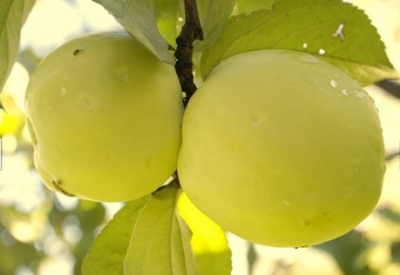
- Taste: sweet with sourness
- Scent: pineapple
- Fruit weight, g: 150 — 200
- Yield: high
- The beginning of fruiting varieties: 3 years after planting
- Ripening terms: late winter
- Removable maturity: at the end of September
- Duration of the consumer period: from September to February
- Appointment: universal
- Transportability: Yes
If you want to grow an apple tree with unique taste on your site, then you should definitely take a closer look at the Pineapple variety, which, among other things, is highly resistant to some common diseases of fruit trees.
Description of the variety
The apple tree Pineapple grows 3.5 meters high. The crown is formed by a dense, neat, rounded pyramidal shape.
Features, pros and cons
One of the main advantages of this variety is the taste of apples. It's hard not to notice the pleasant pineapple aftertaste. In addition, Pineapple is not afraid of spring frosts, copes well with temperature fluctuations. Of the advantages, experts also note high resistance to scab and powdery mildew. The fruits can be stored for about 4-5 months. Moreover, trees bring crops every year.
But this variety also has its drawbacks. Due to the high height of the tree, it is not easy to care for it. There is also a low resistance to insect damage and other diseases.
Ripening and fruiting
Pineapple is a late winter variety with removable maturity at the end of September. The consumer period begins from September to February. Fruits can be harvested as early as 3 years of apple growing.
Yield
The yield of this variety is assessed as high.
Fruits and their taste
You can make compotes from the fruits of the Pineapple, make jam, they are also used fresh. An attractive golden yellow hue sometimes obscures a slight blush.
The skin of apples is dense, has an attractive sheen and a light waxy coating. They taste sweet, but there is a slight sourness. The pulp is fine-grained, juicy. The aroma is similar to the smell of pineapple.
The fruits can be transported, while their presentation is preserved.

Growing features
Young Pineapple trees that are used for vertical cultivation must be pruned one third each winter until they reach the top of the trellis. As a result of such pruning, the tree takes on an ideal shape.
The main lateral shoots are removed at the end of autumn up to 3 buds from the main vertical stem, and any lateral shoots - up to one / two buds.
In the spring of the second year, premature flowers are carefully removed as they appear, leaving the basal leaves intact. This should only be done in the second year after planting.
From mid-summer to early autumn, cut off all unnecessary side shoots up to three leaves.



Pollination
When growing any apple tree, you should seriously think about pollinators. Insects like bees and butterflies don't always do the job properly. There can be many reasons for this. For example, bad weather conditions or the gardener used the insecticide at the wrong time, which also affected the pollinators.
To get a stable harvest, it is better to plant a different apple tree on the site, within 30 meters from Pineapple. It is imperative that it bloom at the same time as the plant.
Top dressing
Mature trees can bear fruit fairly well without fertilization, but performance will improve with annual application of quality, mineral-rich formulations.
The Pineapple apple tree responds well to rotted manure and humus. Mineral supplements with slow release of micro and macro elements can be used. They are laid around the tree under mulch. When watering, the required amount of potassium, boron, magnesium will be released into the soil, thereby nourishing the plant.

Frost resistance
The variety is resistant to frost and spring frosts.

Diseases and pests
To protect the tree from diseases and pests, it is worth using fungicides and insecticides. The first treatment is carried out in the spring, while the buds are still dormant. Then the procedure is repeated every 7-10 days, but not necessarily in rainy weather. You can not process the plant during the harvest period.

The apple tree is a popular fruit crop among gardeners. It can be found in many summer cottages. But at the same time, such trees are often affected by various diseases. It is very important to recognize the disease in time and carry out the necessary procedures for a speedy recovery. Otherwise, the fruits will be spoiled, and the tree itself may die altogether.












































































